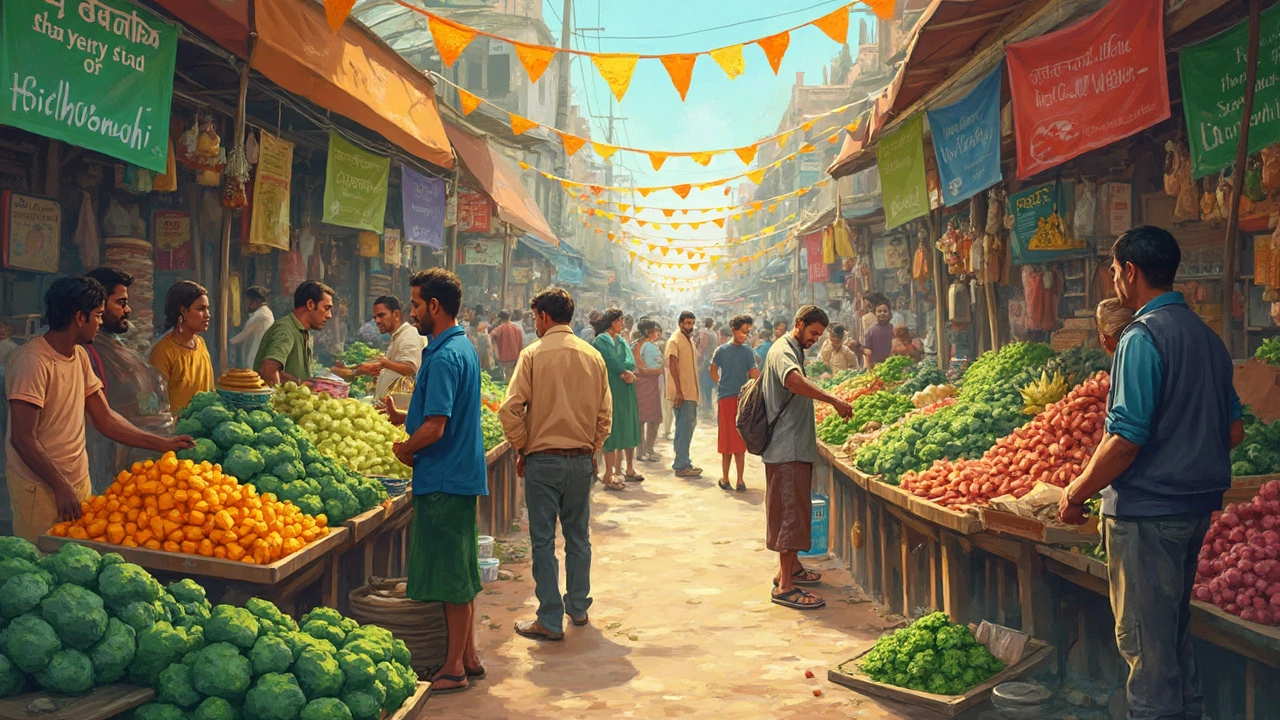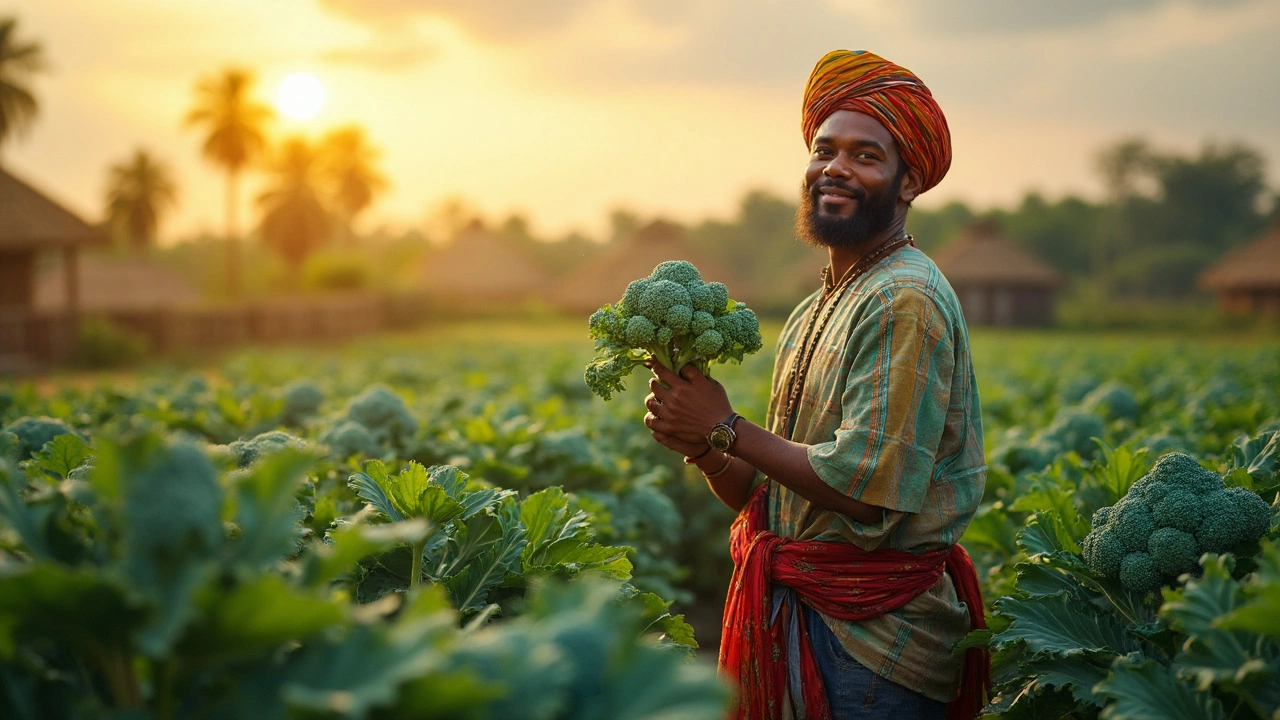So, you're thinking about broccoli farming in India? You're in the right spot. While not the typical crop you'd associate with the vast Indian agricultural landscape, broccoli is steadily making its mark. The growing middle-class, with an increasing awareness of health benefits and a penchant for western cuisines, is driving up the demand for this green veggie.
But can you really make money off it? Well, like any farming venture, it's not all sunshine and rainbows. The profitability of broccoli farming hinges on a mix of the right climate, soil, and your willingness to get your hands a little dirty. The good news is that broccoli grows well in temperate zones, which are found in parts of India.
You've got to think about the costs, though. Starting up requires some investment, but if you nail it, the returns can be pretty sweet. Stay tuned as we dive deeper into what makes broccoli farming in India tick and how you can tap into its potential.
- Introduction to Broccoli Farming in India
- Climate and Soil Requirements
- Investment and Initial Setup
- Cultivation Practices and Tips
- Market Potential and Sales Strategies
- Common Challenges and Solutions
Introduction to Broccoli Farming in India
Broccoli, once a stranger in Indian kitchens, is now making waves. Thanks to a rise in health-conscious eating, farmers are seeing potential in this vibrant green veggie. Why? Because of its nutritious punch and versatility in dishes. And if you're thinking of jumping on the broccoli farming bandwagon, you're not alone.
The climate thing is key here. Broccoli thrives in cooler temperatures, which means places like Himachal Pradesh and parts of Uttarakhand are pretty spot on. Even the Nilgiris in Tamil Nadu are kicking up their broccoli game. Not too shabby, right?
"Broccoli cultivation aligns well with the trends toward healthy eating in urban centers," says Dr. R.K. Sharma from the Agricultural University in Palampur. "Farmers with the right conditions should consider diving into this market."
But what’s it really like to grow broccoli in India? First off, it needs well-drained soil rich in organic matter. We’re talking pH levels around 6 to 7. Don’t stress if this feels like high school chemistry – the right soil mixture is just a google search away.
- Climate Zones: Best in temperate regions.
- Soil Type: Prefers loamy soil, ideally rich in organic content.
- Growing Season: Usually planted during the cooler months.
Getting into broccoli farming isn't just about planting seeds; it’s about understanding what the market wants. And right now, urban areas are seeing a veggie revolution, where healthier options like broccoli are in demand. So, if you’re ready to explore this green opportunity, stay tuned for more!
Climate and Soil Requirements
If you're considering diving into broccoli farming in India, understanding the climate and soil needs is crucial. This crop isn't as fussy as it sounds, but there are a few things you can't overlook if you want to make it work.
Broccoli thrives in cooler conditions, with an ideal temperature range between 15-20°C. In India, this usually means the winter season, so timing the planting right is key. If you're in the plains, sowing should typically start around September to ensure that it avoids extreme heat.
Soil quality is another biggie. Broccoli prefers well-drained, loamy soils rich in organic matter. If your soil's acidic, like below a pH of 6, you might want to think about liming. Proper drainage should prevent waterlogging, which can be a real issue with this crop, leading to root rot.
Here's a basic rundown of things to check in your soil:
- pH Level: Aim for 6.0-7.0
- Organic Matter: Rich soils do wonders
- Drainage: Avoid heavy clay that retains water
- Fertility: Moderate levels of nitrogen are needed
If these climate and soil elements line up for you, then you’ve got the green light to explore the many opportunities in the broccoli market in India.
Investment and Initial Setup
Diving into broccoli farming means putting in some initial investment, but don't worry, it's not as daunting as it sounds. The first thing you'll need to figure out is the land. Ideally, you'd want about an acre to get started. Costs will vary depending on the location, but having your own land is a bonus.
Next up is preparing the soil. Broccoli loves slightly acidic to neutral pH levels, typically between 6.0 and 7.0. You might need to invest in testing and adjusting your soil accordingly. Adding organic compost can help enrich the soil, setting you up for a good harvest.
When it comes to seeds, you want to pick high-quality seeds. The initial cost for seeds can range from ₹2000 to ₹5000 for an acre. Then, you'll need fertilizers and pest control, which might set you back another ₹5000 to ₹7000. But like they say, you get what you pay for, right?
Setting up an irrigation system is another crucial part. While the cost can vary, basic drip irrigation systems might see you spending around ₹20,000 per acre. Given India's water issues, efficient irrigation will save you money in the long haul.
- Land preparation and soil testing: ₹10,000 - ₹15,000
- High-quality seeds: ₹2000 - ₹5000 per acre
- Fertilizers and pest control: ₹5000 - ₹7000
- Irrigation setup: ₹20,000 per acre
Don't forget labor costs, whether you're hiring help or doing it solo, keep that in mind. And while machinery like tractors can help, they aren't strictly necessary, especially if you're starting small.
Once you've got your setup, you'll find that profitable agriculture isn't just a dream. Broccoli has three planting seasons in India, particularly in cooler regions, allowing you to maximize your yield and revenue throughout the year.

Cultivation Practices and Tips
Alright, let's talk about how to get your broccoli farming game on point. First up, knowing the right time to plant is crucial. Broccoli thrives in cool weather, so aim to plant it from October to February in India. That way, it can grow without the scorching summer sun beating down on it.
Now, the soil. Broccoli loves well-drained sandy loam with a pH between 6.0 and 7.5. Before you start planting, give that soil some love with organic compost or manure to amp up the nutrients. Trust me, your vegetable gardening efforts will thank you for it.
Here's how you should be handling the planting part:
- Spacing: Keep seedlings about 50 cm apart, with rows spaced 60 cm from each other. This allows for ample growth space.
- Watering: Maintain consistent moisture, especially during the early stages. Drip irrigation works great for conserving water and ensuring even distribution.
- Fertilization: Use a balanced NPK (Nitrogen, Phosphorus, Potassium) fertilizer once the plants are a few weeks old. Regular boosts can keep them healthy and green.
Pests and diseases can be a bit of a hassle. Keep an eye out for aphids and caterpillars. Neem oil sprays can be your best friend here, offering a natural remedy without harming the plants.
Wondering when to harvest? Look for firm heads before they start flowering. Typically, 90 to 100 days after planting, you'll see those vibrant green heads ready to pick.
| Average Yield (tons/acre) | Potential Revenue (INR/acre) |
|---|---|
| 5-8 | 150,000 - 240,000 |
This table shows potential yields and revenues that can give you a sense if broccoli farming in India is worth it. With good practices, both the yield and profit margins can be promising.
Market Potential and Sales Strategies
The demand for broccoli farming in India is on the upswing, fueled by health-conscious consumers and evolving dietary habits. With more people leaning toward green, nutritious options, broccoli is finding its way into home kitchens and restaurant menus. But how does this translate into market opportunities for growers?
Firstly, understanding the target market is crucial. Urban areas offer a significant opportunity due to a larger population interested in healthier food choices. Tapping into cities can be your best bet. Additionally, with the popularity of organic produce, organic broccoli could fetch even higher prices.
In terms of actual sales strategies, building relationships with local retailers and grocery chains can provide a steady sales outlet. Engaging with farmer markets is another avenue, allowing direct access to consumers who appreciate local produce. You can even consider selling to hotels and restaurants by offering a reliable supply of fresh broccoli. Establishing strong ties here can be mutually beneficial.
Let's look at a few tips that can enhance your sales strategy:
- Leverage social media to market your broccoli. Sharing stories from your farm can personalize your brand and attract customers.
- Offer taste tests or small samples at local events. Not everyone knows the versatility of broccoli, and getting people to try it can lead to long-term buyers.
- Create subscription boxes or weekly veggie deliveries to reach more households directly.
Here's a snapshot of the potential broccoli market penetration:
| Market Segment | Percentage of Demand |
|---|---|
| Urban Consumers | 40% |
| Restaurants and Hotels | 35% |
| Local Grocery Chains | 20% |
| Farmer Markets | 5% |
Navigating the broccoli market isn't just about growing the vegetable; it's about building a brand and connecting with your buyers. Stay attuned to market trends, and always think about ways to add value. By understanding and implementing solid sales strategies, your broccoli farming efforts in India can be turned into a profitable business.
Common Challenges and Solutions
Jumping into broccoli farming in India sounds exciting, right? But as with anything, there's a catch. Several hurdles might make you scratch your head, but don't worry, 'cause we've got some solutions up our sleeves.
One major hiccup is the climate. Broccoli likes it cool, which isn't exactly India's go-to weather. So, you'll need to play it smart with planting seasons. Pick regions that offer a cooler climate, especially in states like Himachal Pradesh or parts of Karnataka.
"Adapting our planting and harvesting cycles to local climate patterns has helped increase our yield significantly," says Suresh Kumar, a farmer from Bangalore who's been in the game for over a decade.
Then there's the issue of pests and diseases. Broccoli is like a buffet for certain critters, so regular monitoring is key. Use natural pesticides where possible, so you don't harm the environment or your consumers.
- Keep an eye out for root maggots and aphids.
- Practice crop rotation to keep your soil healthy.
- Use neem oil as a natural pest deterrent.
Speaking of soil, broccoli isn't a fan of all types. You're best off with well-drained, fertile soil that's packed with organic content. Performing a soil test before planting can save you some headaches.
Marketing and sales can be a tough nut to crack too. With competition increasing, establishing ties with local grocers and exploring online platforms to sell directly to consumers can add value. Always keep an ear to the ground and adapt your strategy based on market needs.
Farmers also struggle with pricing, as market rates can fluctuate. Having partnerships with buyers who commit to a steady price can cushion you from the ups and downs.
- Attend agricultural fairs to network with potential buyers.
- Consider forming or joining a cooperative for better bargaining power.
Remember, each challenge has a workaround. By staying informed and flexible, your broccoli venture can thrive amidst the challenges. Those green heads might not just fill plates but also pockets!


